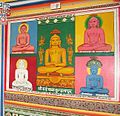
Mahavira, also known as Vardhamana, was the founder of Jainism and the 24th Tirthankara. He was the spiritual successor of the 23rd Tirthankara Parshvanatha. Mahavira was born in the early 6th century BCE to a royal Jain family of ancient India. His mother's name was Trishala and his father's name was Siddhartha. They were lay devotees of Parshvanatha. Mahavira abandoned all worldly possessions at the age of about 30 and left home in pursuit of spiritual awakening, becoming an ascetic. Mahavira practiced intense meditation and severe austerities for twelve and a half years, after which he attained Kevala Jnana (omniscience). He preached for 30 years and attained moksha (liberation) in the 6th century BCE, although the year varies by sect.

Mahavir Janma Kalyanak is one of the most important religious festivals in Jainism. It celebrates the birth of Mahavira, the twenty-fourth and last Tirthankara of present Avasarpiṇī. On the Gregorian calendar, the holiday occurs either in March or April.

Damoh is a city in the Indian state of Madhya Pradesh. It is known for The Bade Baba Temple at Kundalpur, a Jain pilgrimage site. It is one of the major cities of Madhya Pradesh. The city is also the district headquarters of Damoh district.

Parshvanatha, or Pārśva and Pārasanātha, was the 23rd of 24 Tirthankaras of Jainism. He gained the title of Kalīkālkalpataru.

Bundelkhand, a region in central India, has been an ancient center of Jainism. It covers northern part of Madhya Pradesh and south western part of Uttar Pradesh.
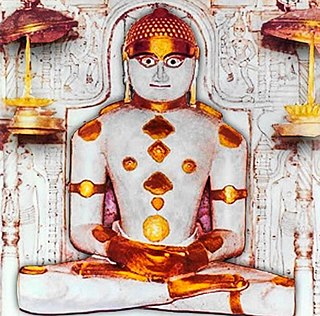
Rishabhanatha, also Rishabhadeva, Rishabha or Ikshvaku, is the first tirthankara of Jainism. He was the first of twenty-four teachers in the present half-cycle of time in Jain cosmology, and called a "ford maker" because his teachings helped one cross the sea of interminable rebirths and deaths. The legends depict him as having lived millions of years ago. He was the spiritual successor of Sampratti Bhagwan, the last Tirthankara of previous time cycle. He is also known as Ādinātha, as well as Adishvara, Yugadideva, Prathamarajeshwara and Nabheya. He is also known as Ikshvaku, establisher of the Ikshvaku dynasty. Along with Mahavira, Parshvanath, Neminath, and Shantinath, Rishabhanatha is one of the five Tirthankaras that attract the most devotional worship among the Jains.
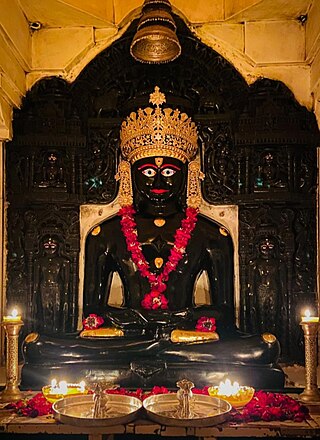
Nemināth, also known as Nemi and Ariṣṭanemi, is the twenty-second tirthankara of Jainism in the present age. Neminath lived 81,000 years before the 23rd Tirthankar Parshvanath. According to traditional accounts, he was born to King Samudravijaya and Queen Shivadevi of the Yadu dynasty in the north Indian city of Sauripura. His birth date was the fifth day of Shravan Shukla of the Jain calendar. Krishna, who was the 9th and last Jain Vasudev, was his first cousin.
Jainism is a religion founded in ancient India. Jains trace their history through twenty-four tirthankara and revere Rishabhanatha as the first tirthankara. The last two tirthankara, the 23rd tirthankara Parshvanatha and the 24th tirthankara Mahavira are considered historical figures. According to Jain texts, the 22nd tirthankara Neminatha lived about 5,000 years ago and was the cousin of Krishna.
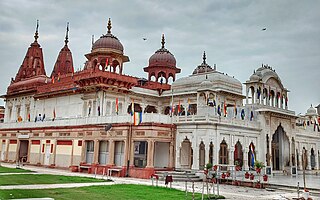
Shri Mahavir Ji is an important and prominent Digambar Jain pilgrimage site situated in Shri Mahaveerji town in Hindaun Block, Karauli district in Rajasthan. Given the importance of the religious place, the Indian Railways has specifically developed a railway station under West Central Railway zone by the name of Shri Mahaveerji railway station which is 10 minutes drive from the temple and temple authorities have arranged for regular buses from the station to the temple. The temple is visited by millions of Jain and Hindu devotees every year.
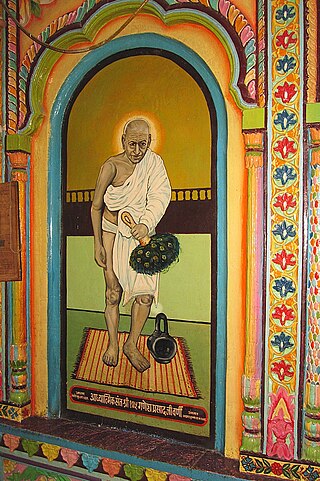
Kshullak Ganeshprasad Varni was one of the foundational figures of the modern Indian Digambara intellectual tradition during the early 20th century. He was the founder of several schools and institutions of advanced learning including Syadvad Mahavidyalaya at Varanasi in 1905, Varanasi and Satark-Sudhataringini Digamber Jain Pathshala, now Ganesh Digamber Jain Sanskrit Vidyalaya at Sagar.

Uttar Pradesh, a state in north India has a long association with Jainism. Today the state is home to a number of Jain monuments, such as Jain Temples and Jain Tirths. There are around 213,267 Jains in Uttar Pradesh according to 2011 Census of India.

Jain sculptures or Jain idols are the images depicting Tirthankaras. These images are worshiped by the followers of Jainism. The sculpture can depict any of the twenty-four tirthankaras with images depicting Parshvanatha, Rishabhanatha, or Mahāvīra being more popular. Jain sculptures are an example of Jain art. There is a long history of construction of Jain sculptures. Early examples include Lohanipur Torsos which has been regarded to be from the Maurya period, and images from the Kushan period from Mathura.

Jain art refers to religious works of art associated with Jainism. Even though Jainism has spread only in some parts of India, it has made a significant contribution to Indian art and architecture.
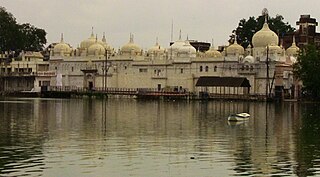
Bara Mandir is a historic Jain temple in Jabalpur, India, right on the edge of Hanumantal, once the main center of Jabalpur.

Jainism in Bihar trace a long history since the times of twenty-fourth Tirthankara Mahavira, who was born in Vaishali. The state of Bihar is considered to have played an important role in the development of Jainism.

Nainagiri is a major pilgrimage site for Jainism in India. It is located in the central Indian state of Madhya Pradesh, it is 12 km from Dalpatpur and 25 km from Bukswaha. This tirth, also known as Reshandigiri, is a Siddha Kshetra where five ancient saints including Varadatta had attained nirvana.

Siddhachal Caves are Jain cave monuments and statues carved into the rock face inside the Urvashi valley of the Gwalior Fort in northern Madhya Pradesh, India. There are the most visited among the five groups of Jain rock carvings on the Gwalior Fort hill. They were built over time starting in the 7th-century, but most are dated to the 15th-century CE. Many of the statues were defaced and destroyed under the orders of the Muslim Emperor Babur of the Mughal dynasty in the 16th century, while a few repaired and restored after the fall of the Mughal dynasty and through the late 19th century.
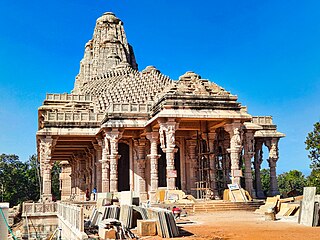
Sarvodaya Jain temple is a Jain temple in Amarkantak town in Anuppur, Madhya Pradesh. Nearest airport is Raipur C.G. and nearest railway station is Pendra road C.G. You can also reach easily from Bilaspur CG and Anuppur MP, by Car. Rental car, taxi and auto rickshaw are easily available From Pendra Road. Many Lodges, Ashram and Hotels are available in Amarkantak and as well as Pendraroad. Amarkantak is a well-known Teerth. It is famous for beautiful Nature, mountains and climate. Ma Narmada Temple, Narmada kund, Kapil dhara, Dudh Dhara, Son muda, Mai ki bahiya, Durga dhara, Bhrigu kamandal, Arandi ashram, Kalyan ashram and many more attractive places are Beauty of Amarkantak. Beauty and architecture of Sarvoday Jain temple is also remarkable.

Bade Baba Temple, Kundalpur is a temple in Kundalpur, a pilgrimage town for Jains, in Damoh district of Madhya Pradesh. It is 35 km from Damoh. The Bade Baba Temple was formally known as Shri Digamber Jain Siddha Kshetra Kundalpur.




